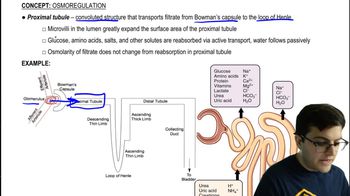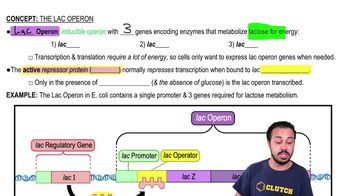Table of contents
- 1. Introduction to Biology2h 42m
- 2. Chemistry3h 40m
- 3. Water1h 26m
- 4. Biomolecules2h 23m
- 5. Cell Components2h 26m
- 6. The Membrane2h 31m
- 7. Energy and Metabolism2h 0m
- 8. Respiration2h 40m
- 9. Photosynthesis2h 49m
- 10. Cell Signaling59m
- 11. Cell Division2h 47m
- 12. Meiosis2h 0m
- 13. Mendelian Genetics4h 44m
- Introduction to Mendel's Experiments7m
- Genotype vs. Phenotype17m
- Punnett Squares13m
- Mendel's Experiments26m
- Mendel's Laws18m
- Monohybrid Crosses19m
- Test Crosses14m
- Dihybrid Crosses20m
- Punnett Square Probability26m
- Incomplete Dominance vs. Codominance20m
- Epistasis7m
- Non-Mendelian Genetics12m
- Pedigrees6m
- Autosomal Inheritance21m
- Sex-Linked Inheritance43m
- X-Inactivation9m
- 14. DNA Synthesis2h 27m
- 15. Gene Expression3h 20m
- 16. Regulation of Expression3h 31m
- Introduction to Regulation of Gene Expression13m
- Prokaryotic Gene Regulation via Operons27m
- The Lac Operon21m
- Glucose's Impact on Lac Operon25m
- The Trp Operon20m
- Review of the Lac Operon & Trp Operon11m
- Introduction to Eukaryotic Gene Regulation9m
- Eukaryotic Chromatin Modifications16m
- Eukaryotic Transcriptional Control22m
- Eukaryotic Post-Transcriptional Regulation28m
- Eukaryotic Post-Translational Regulation13m
- 17. Viruses37m
- 18. Biotechnology2h 58m
- 19. Genomics17m
- 20. Development1h 5m
- 21. Evolution3h 1m
- 22. Evolution of Populations3h 53m
- 23. Speciation1h 37m
- 24. History of Life on Earth2h 6m
- 25. Phylogeny2h 31m
- 26. Prokaryotes4h 59m
- 27. Protists1h 12m
- 28. Plants1h 22m
- 29. Fungi36m
- 30. Overview of Animals34m
- 31. Invertebrates1h 2m
- 32. Vertebrates50m
- 33. Plant Anatomy1h 3m
- 34. Vascular Plant Transport1h 2m
- 35. Soil37m
- 36. Plant Reproduction47m
- 37. Plant Sensation and Response1h 9m
- 38. Animal Form and Function1h 19m
- 39. Digestive System1h 10m
- 40. Circulatory System1h 49m
- 41. Immune System1h 12m
- 42. Osmoregulation and Excretion50m
- 43. Endocrine System1h 4m
- 44. Animal Reproduction1h 2m
- 45. Nervous System1h 55m
- 46. Sensory Systems46m
- 47. Muscle Systems23m
- 48. Ecology3h 11m
- Introduction to Ecology20m
- Biogeography14m
- Earth's Climate Patterns50m
- Introduction to Terrestrial Biomes10m
- Terrestrial Biomes: Near Equator13m
- Terrestrial Biomes: Temperate Regions10m
- Terrestrial Biomes: Northern Regions15m
- Introduction to Aquatic Biomes27m
- Freshwater Aquatic Biomes14m
- Marine Aquatic Biomes13m
- 49. Animal Behavior28m
- 50. Population Ecology3h 41m
- Introduction to Population Ecology28m
- Population Sampling Methods23m
- Life History12m
- Population Demography17m
- Factors Limiting Population Growth14m
- Introduction to Population Growth Models22m
- Linear Population Growth6m
- Exponential Population Growth29m
- Logistic Population Growth32m
- r/K Selection10m
- The Human Population22m
- 51. Community Ecology2h 46m
- Introduction to Community Ecology2m
- Introduction to Community Interactions9m
- Community Interactions: Competition (-/-)38m
- Community Interactions: Exploitation (+/-)23m
- Community Interactions: Mutualism (+/+) & Commensalism (+/0)9m
- Community Structure35m
- Community Dynamics26m
- Geographic Impact on Communities21m
- 52. Ecosystems2h 36m
- 53. Conservation Biology24m
16. Regulation of Expression
Eukaryotic Transcriptional Control
Problem 5b
Textbook Question
Compare and contrast the items in each pair:
(b) promoter-proximal elements and the operator of the lac operon
 Verified step by step guidance
Verified step by step guidance1
Understand the role of promoter-proximal elements: These are regulatory sequences located near the promoter of a gene. They are important for the initiation of transcription and can be bound by transcription factors to increase or decrease the rate of transcription.
Understand the role of the operator in the lac operon: The operator is a specific DNA sequence in the lac operon that acts as a binding site for the repressor protein. When the repressor is bound to the operator, it prevents RNA polymerase from transcribing the genes necessary for lactose metabolism.
Compare the location of promoter-proximal elements and the operator: Promoter-proximal elements are located upstream of the promoter, whereas the operator is located downstream of the promoter, within the operon itself.
Contrast the function of promoter-proximal elements and the operator: Promoter-proximal elements generally regulate the transcription of a wide range of genes by interacting with transcription factors, while the operator specifically regulates the transcription of genes in the lac operon by interacting with the lac repressor.
Consider the regulatory mechanisms: Promoter-proximal elements can be involved in both positive and negative regulation depending on the transcription factors that bind to them, whereas the operator primarily functions in negative regulation by blocking transcription when the repressor is bound.
 Verified video answer for a similar problem:
Verified video answer for a similar problem:This video solution was recommended by our tutors as helpful for the problem above
Video duration:
54sPlay a video:
Was this helpful?
Key Concepts
Here are the essential concepts you must grasp in order to answer the question correctly.
Promoter-Proximal Elements
Promoter-proximal elements are regulatory DNA sequences located near the promoter of a gene. They play a crucial role in the initiation of transcription by providing binding sites for transcription factors, which can enhance or repress the transcription of the associated gene. These elements are essential for the precise regulation of gene expression in eukaryotic cells.
Recommended video:
Guided course

Proximal Tubule
Operator of the Lac Operon
The operator is a specific DNA sequence within the lac operon in prokaryotes, particularly E. coli, that acts as a binding site for the repressor protein. When the repressor binds to the operator, it prevents RNA polymerase from transcribing the downstream genes involved in lactose metabolism. This mechanism allows the cell to regulate gene expression in response to the presence or absence of lactose.
Recommended video:
Guided course

The Lac Operon
Gene Regulation in Prokaryotes vs. Eukaryotes
Gene regulation in prokaryotes, such as the lac operon, often involves operons where genes are transcribed together and regulated by a single operator. In contrast, eukaryotic gene regulation involves complex interactions with promoter-proximal elements and multiple transcription factors, allowing for more precise and varied control of gene expression. This difference reflects the complexity and diversity of eukaryotic cellular functions.
Recommended video:
Guided course

Introduction to Eukaryotic Gene Regulation

 3:32m
3:32mWatch next
Master Introduction to Transcription Factors with a bite sized video explanation from Jason
Start learningRelated Videos
Related Practice
Textbook Question
Compare and contrast the items in each pair: (a) enhancers and the E. coli CAP binding site
630
views
